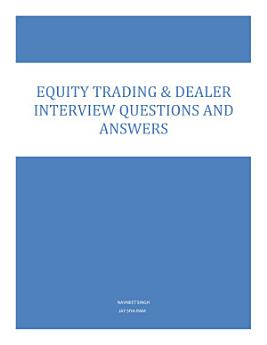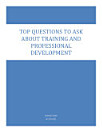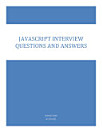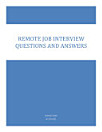Equity Trading & Dealer Interview Questions and Answers - English
About this ebook
1. What is the difference between a market maker and a broker in equity trading?
Answer: A market maker is a firm or individual that stands ready to buy and sell securities at specified prices, maintaining liquidity in the market. They profit from the bid-ask spread. A broker, on the other hand, facilitates transactions between buyers and sellers and earns a commission for their services. Brokers do not take on risk by holding securities in inventory.
2. Can you explain what a limit order and a market order are?
Answer: A limit order is an order to buy or sell a stock at a specified price or better. For a buy order, it will only execute at the limit price or lower; for a sell order, it will only execute at the limit price or higher. A market order is an order to buy or sell a stock immediately at the current market price. Market orders are executed quickly but may not guarantee the exact price.
3. How do you evaluate whether a stock is undervalued or overvalued?
Answer: I would evaluate the stock using a combination of fundamental analysis and technical analysis:
Fundamental Analysis: I would analyse key metrics such as earnings per share (EPS), price-to-earnings (P/E) ratio, price-to-book (P/B) ratio, debt-to-equity ratio, and compare these with industry averages and historical performance.
Technical Analysis: I would look at the stock’s price action, moving averages, support and resistance levels, volume patterns, and indicators like RSI and MACD to gauge momentum and trends.
4. What is the role of risk management in equity trading?
Answer: Risk management is crucial in equity trading to minimize potential losses and maximize returns. This includes:
Position sizing: Determining how much capital to allocate to each trade.
Stop-loss orders: Setting predefined levels where positions are automatically exited to limit losses.
Diversification: Spreading risk by holding a mix of assets or securities.
Hedging: Using instruments like options or futures to protect against market downturns.
5. What is a short sale and when would you consider doing it?
Answer: A short sale is when you borrow shares of a stock and sell them at the current market price, hoping to buy them back later at a lower price. It is a bearish strategy, used when you believe a stock’s price will decline. Shorting is often considered when there’s strong conviction about overvaluation, poor fundamentals, or an expected downturn in the market or sector.
6. Explain the concept of liquidity and its importance in trading.
Answer: Liquidity refers to how easily an asset can be bought or sold in the market without affecting its price. High liquidity means that there is a large number of buy and sell orders, and trades can be executed quickly at the market price. Liquidity is important because it allows traders to enter and exit positions efficiently without significant price slippage.
7. How would you handle a situation where a client has a large position in a stock that is moving sharply against them?
Answer: I would evaluate the situation and consider the following:
Market conditions: I’d look at the broader market sentiment and any news affecting the stock.
Stop-losses: I’d ensure that appropriate stop-loss orders are in place to limit potential losses.
Hedging: I might recommend hedging the position with options or futures to mitigate further losses.
Position reduction: If the position is too large and the risk is too high, I’d consider reducing the size or exiting part of the position.
Communication: I would communicate with the client to discuss the situation, explain potential outcomes, and provide suggestions.
8. What technical indicators do you rely on for equity trading?
Answer: I rely on a combination of indicators:
Moving Averages (e.g., 50-day, 200-day): Used to identify trends and potential reversal points.
RSI (Relative Strength Index): Helps identify overbought or oversold conditions, suggesting potential reversal points.
MACD (Moving Average Convergence Divergence): Useful for identifying momentum and trend changes.
Bollinger Bands: To assess volatility and overbought/oversold levels.
Volume: Helps confirm the strength of a price move.
9. What is your approach to dealing with market volatility?
Answer: I would use several strategies to manage volatility:
Hedging: Using options or futures to offset potential losses from a volatile market.
Diversification: Ensuring that the portfolio is not overly exposed to any single asset or sector.
Staying informed: Keeping an eye on market news and economic indicators to anticipate shifts.
Discipline: Sticking to a well-defined risk management strategy, such as setting stop-loss orders and maintaining appropriate position sizes.
10. What is the role of an equity trader in a dealer position?
Answer: An equity trader in a dealer position is responsible for making markets, which involves buying and selling equities to provide liquidity to clients or institutional investors. They quote bid-ask prices and may take on inventory risk, aiming to make a profit from the spread between the bid and ask prices. They also manage the firm's risk exposure by executing trades on behalf of clients and may use hedging strategies to protect against market moves.
These questions and answers aim to test both technical and practical knowledge of equity trading and the role of a dealer. Being prepared with solid answers to these types of questions can help you demonstrate both your trading expertise and your understanding of the markets.








